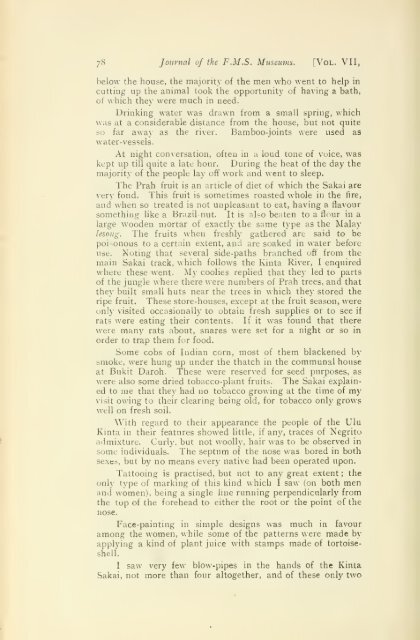Journal of the Federated Malay States museums - Sabrizain.org
Journal of the Federated Malay States museums - Sabrizain.org
Journal of the Federated Malay States museums - Sabrizain.org
You also want an ePaper? Increase the reach of your titles
YUMPU automatically turns print PDFs into web optimized ePapers that Google loves.
78 <strong>Journal</strong> <strong>of</strong> <strong>the</strong> F.M.S. Museums. [Vol. VII,<br />
below <strong>the</strong> house, <strong>the</strong> majority <strong>of</strong> <strong>the</strong> men who went to help in<br />
cutting up <strong>the</strong> animal took <strong>the</strong> opportunity <strong>of</strong> having a bath,<br />
ot which <strong>the</strong>y were much in need.<br />
Drinking water was drawn from a small spring, which<br />
was at a considerable distance from <strong>the</strong> house, but not quite<br />
so far away as <strong>the</strong> river. Bamboo-joints were used as<br />
water-vessels.<br />
At night conversation, <strong>of</strong>ten in a loud tone <strong>of</strong> voice, was<br />
kept up till quite a late hour. During <strong>the</strong> heat <strong>of</strong> <strong>the</strong> day <strong>the</strong><br />
majority <strong>of</strong> <strong>the</strong> people lay <strong>of</strong>f work and went to sleep.<br />
The Prah fruit is an article <strong>of</strong> diet <strong>of</strong> which <strong>the</strong> Sakai are<br />
very fond. This fruit is sometimes roasted whole in <strong>the</strong> lire,<br />
and when so treated is not unpleasant to eat, having a flavour<br />
something like a Brazil nut. It is also beaten to a flour in a<br />
large wooden mortar <strong>of</strong> exactly <strong>the</strong> same type as <strong>the</strong> <strong>Malay</strong><br />
lesong. The fruits when freshly ga<strong>the</strong>red are said to be<br />
poisonous to a certain extent, and are soaked in water before<br />
use. Noting that several side-paths branched <strong>of</strong>f from <strong>the</strong><br />
main Sakai track, which follows <strong>the</strong> Kinta River, I enquired<br />
where <strong>the</strong>se went. My coolies replied that <strong>the</strong>y led to parts<br />
<strong>of</strong> <strong>the</strong> jungle where <strong>the</strong>re were numbers <strong>of</strong> Prah trees, and that<br />
<strong>the</strong>y built small huts near <strong>the</strong> trees in which <strong>the</strong>y stored <strong>the</strong><br />
ripe fruit. These store-houses, except at <strong>the</strong> fruit season, were<br />
only visited occasionally to obtain fresh supplies or to see if<br />
rats were eating <strong>the</strong>ir contents. If it was found that <strong>the</strong>re<br />
were many rats about, snares were set for a night or so in<br />
order to trap <strong>the</strong>m for food.<br />
Some cobs <strong>of</strong> Indian corn, most <strong>of</strong> <strong>the</strong>m blackened by<br />
smoke, were hung up under <strong>the</strong> thatch in <strong>the</strong> communal house<br />
at Bukit Daroh. These were reserved for seed purposes, as<br />
were also some dried tobacco-plant fruits. The Sakai explained<br />
to me that <strong>the</strong>y had no tobacco growing at <strong>the</strong> time <strong>of</strong> my<br />
visit owing to <strong>the</strong>ir clearing being old, for tobacco only grows<br />
well on fresh soil.<br />
With regard to <strong>the</strong>ir appearance <strong>the</strong> people <strong>of</strong> <strong>the</strong> Ulu<br />
Kinta in <strong>the</strong>ir features showed little, if any, traces <strong>of</strong> Negrito<br />
admixture. Curly, but not woolly, hair was to be observed in<br />
some individuals. The septum <strong>of</strong> <strong>the</strong> nose was bored in both<br />
sexes, but by no means every native had been operated upon.<br />
Tattooing is practised, but not to any great extent ; <strong>the</strong><br />
only type <strong>of</strong> marking <strong>of</strong> this kind which I saw (on both men<br />
anil women), being a single line running perpendicularly from<br />
<strong>the</strong> top <strong>of</strong> <strong>the</strong> forehead to ei<strong>the</strong>r <strong>the</strong> root or <strong>the</strong> point <strong>of</strong> <strong>the</strong><br />
nose.<br />
Face-painting in simple designs was much in favour<br />
among <strong>the</strong> women, while some <strong>of</strong> <strong>the</strong> patterns were made by<br />
applying a kind <strong>of</strong> plant juice with stamps made <strong>of</strong> tortoise-<br />
shell.<br />
I saw very few blow-pipes in <strong>the</strong> hands <strong>of</strong> <strong>the</strong> Kinta<br />
Sakai, not more than four altoge<strong>the</strong>r, and <strong>of</strong> <strong>the</strong>se only two
















